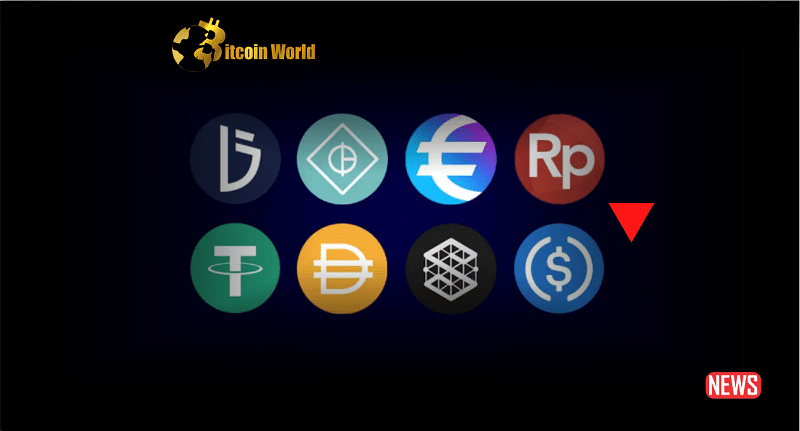The world of stablecoins – those digital currencies pegged to a stable asset like the US dollar – has been a rollercoaster ride. While the overall market has seen a contraction over the past year, one player continues to hold its ground, and even expand its influence: Tether’s USDT. Think of it as the kingpin of the stablecoin world, its grip seemingly only getting stronger. But is its reign unchallenged? Let’s dive into the latest trends and see what’s shaping the stablecoin landscape.
USDT’s March to a New Peak: What’s Driving Its Dominance?
Despite the broader stablecoin market experiencing a decline, USDT’s market capitalization is not just holding steady; it’s surging! In April, it saw a 2.03% increase, bringing it tantalizingly close to its all-time high of $83.7 billion reached in May of the previous year. This isn’t just about maintaining position; USDT is actively increasing its dominance, marking the fifth consecutive month of growth in this area. Currently, it commands a whopping 62.1% of the entire stablecoin market. Why is this happening?
- First-Mover Advantage: USDT has been around for a while, establishing itself as a reliable and widely accepted stablecoin.
- Extensive Network Effects: Its widespread adoption across numerous exchanges and trading pairs makes it the go-to choice for many traders.
- Liquidity: USDT boasts high liquidity, meaning it can be easily bought and sold without significantly impacting its price.
The numbers speak for themselves. USDT is the dominant force on centralized exchanges, accounting for a staggering 79% of all stablecoin trading volume in April. It’s the primary counterparty in a massive 2,931 trading pairs. This widespread integration makes it incredibly convenient for traders to move in and out of different cryptocurrencies.
A Shrinking Pie? The Overall Stablecoin Market Contraction
While USDT thrives, the overall stablecoin market is facing headwinds. CCData’s report highlights a 1.08% decrease in the total market capitalization of the stablecoin sector in April, reaching its lowest point since September 2021. This contraction could be attributed to several factors, including:
- Market Uncertainty: Fluctuations and uncertainty in the broader cryptocurrency market can impact demand for stablecoins.
- Depegging Events: As highlighted in the report, significant depegging events in March led to a sharp 13.6% drop in trading volumes.
- Regulatory Scrutiny: Increased regulatory attention on stablecoins can also contribute to market hesitancy.
The drop in trading volumes is significant, with March seeing $775 billion traded, while only $365 billion had been traded by April 23rd. This indicates a potential cooling off in certain areas of the market.
Enter the Challenger: How TUSD is Gaining Ground on Binance
Despite USDT’s dominance, the stablecoin arena isn’t a one-horse race. Competition is alive and well, and one stablecoin is making significant strides: TrueUSD (TUSD). What’s fueling its recent surge?
Binance, one of the world’s largest cryptocurrency exchanges, introduced zero-fee spot trading for TUSD’s Bitcoin (BTC) and Ethereum (ETH) trading pairs. This strategic move has acted like a rocket booster for TUSD’s market share on the exchange. Think about it: traders can now buy and sell BTC and ETH using TUSD without incurring any trading fees. This is a significant incentive!
The impact has been undeniable. On April 22nd, TUSD’s market share on Binance reached an all-time high of 15.9%, accompanied by a substantial trading volume of $987 million. This demonstrates a clear shift in trader behavior, highlighting the power of incentives in the crypto market.
TUSD vs. USDC: A Shift in the Rankings
The rise of TUSD isn’t just about challenging USDT; it’s also about reshuffling the existing stablecoin hierarchy. For the first time since June 2020, TUSD has overtaken USD Coin (USDC) to become the third-largest stablecoin by trading volume on centralized exchanges, capturing a 6.5% market share. This is a noteworthy achievement, showcasing TUSD’s growing traction within the market.
The BUSD Factor: Regulatory Pressures and Market Share Decline
The stablecoin landscape is also being shaped by regulatory actions. Binance USD (BUSD), another prominent stablecoin, has been facing significant headwinds due to regulatory scrutiny. Investigations by the New York Department of Financial Services (NYDFS), leading to a halt in the minting of new BUSD tokens, and a Wells Notice from the United States Securities and Exchange Commission (SEC) have undoubtedly impacted its market standing. This serves as a reminder of the evolving regulatory environment surrounding stablecoins and its potential impact on market dynamics.
Key Takeaways: What Does This Mean for the Future?
- USDT’s Resilience: Tether’s USDT continues to demonstrate remarkable resilience and dominance in the stablecoin market, even amidst overall market contraction.
- The Power of Incentives: Binance’s zero-fee trading initiative for TUSD has proven to be a powerful catalyst for growth, showcasing the impact of strategic incentives.
- Shifting Dynamics: The stablecoin market is dynamic, with TUSD emerging as a significant contender, surpassing USDC in trading volume.
- Regulatory Influence: Regulatory pressures are playing a crucial role in shaping the stablecoin landscape, as evidenced by the challenges faced by BUSD.
In conclusion, while the overall stablecoin market navigates a period of contraction, USDT’s dominance remains firm. However, the emergence of TUSD, fueled by strategic initiatives like zero-fee trading, highlights the ongoing competition and the potential for shifts in market share. The interplay between market forces and regulatory developments will continue to shape the future of the stablecoin sector, making it a space to watch closely for anyone involved in the cryptocurrency world.
Disclaimer: The information provided is not trading advice, Bitcoinworld.co.in holds no liability for any investments made based on the information provided on this page. We strongly recommend independent research and/or consultation with a qualified professional before making any investment decisions.


